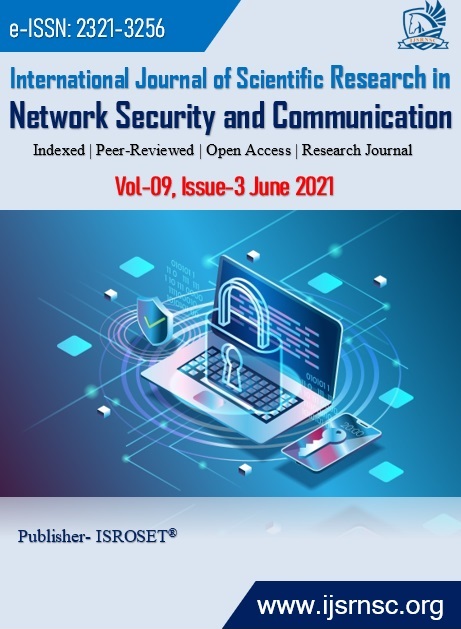Providing a Web Recommender System Using Markov Chains and Registration Files Structure
Keywords:
Markov chains, File structure, Recommendation system, K-means clusteringAbstract
Today, due to the increasing growth of the internet and the huge amount of information we need systems to be able to recommend the most appropriate services and products to the user. The systems that do this are recommender systems. These systems are intelligently using artificial intelligence techniques to identify the interests of your users on the internet and suggest tailored offers to the user’s preferences and interests. Today, Markov models commonly used to predict web pages. For this purpose, in this research, we use a new Markov model and use the structure of registration files to predict the next pages obtained by the user. The proposed Markov model is based on a matrix of 1 to k and in the form of a Markov model which predicts the next pages. In order to reduce the complexity of the search space, as well as to better navigate to the recommender system, we use k-means clustering to group users. The results of the evaluations of the proposed method on the NASA web server log file and in the F-Measure criterion shows 0.57% superiority over BCF.
References
Lu, J., Wu, D., Mao, M., Wang, W., & Zhang, G. (2015). Recommender system application developments: a survey. Decision Support Systems, 74, 12-32.
Ahmadian, S., Joorabloo, N., Jalili, M., Ren, Y., Meghdadi, M., & Afsharchi, M. (2020). A social recommender system based on reliable implicit relationships. Knowledge-Based Systems, 192, 105371.
Rezaeipanah, A., Mojarad, M., & Fakhari, A. (2020). Providing a new approach to increase fault tolerance in cloud computing using fuzzy logic. International Journal of Computers and Applications, 1-9.
Rezaeipanah, A., Ahmadi, G., & Matoori, S. S. (2020). A classification approach to link prediction in multiplex online ego-social networks. Social Network Analysis and Mining, 10(1), 1-16.
Sisodia, D., Singh, L., Sisodia, S., & Saxena, K. (2012). Clustering techniques: a brief survey of different clustering algorithms. International Journal of Latest Trends in Engineering and Technology, 1(3), 82-87.
Lokeshkumar, R., & Sengottuvelan, P. (2014). A Novel Approach to Improve Users Search Goal in Web Usage Mining. International Journal of Computer, Electrical, Automation, Control and Information Engineering, 9(2), 624-628.
Joshi, A., & Kaur, R. (2013). A review: Comparative study of various clustering techniques in data mining. International Journal of Advanced Research in Computer Science and Software Engineering, 3(3), 55-57.
George, A. (2013). Efficient high dimension data clustering using constraint-partitioning k-means algorithm. International Arab Journal of Information Technology, 10(5), 467-476.
Asghari, S., & Navimipour, N. J. (2016). Service composition mechanisms in the multi-cloud environments: a survey. International Journal of New Computer Architectures and Their Applications, 6, 40-48.
Navimipour, N. J., & Milani, F. S. (2015). A comprehensive study of the resource discovery techniques in peer-to-peer networks. Peer-to-Peer Networking and Applications, 8(3), 474-492.
Charband, Y., & Navimipour, N. J. (2016). Online knowledge sharing mechanisms: a systematic review of the state of the art literature and recommendations for future research. Information Systems Frontiers, 18(6), 1131-1151.
Navimipour, N. J., & Asghari, S. (2017). Energy-Aware Service Composition Mechanism in Grid Computing Using an Ant Colony Optimization Algorithm, ICEIC 2017 International Conference on Electronics, Information, and Communication, 282-286.
Asghari, S., & Navimipour, N. J. (2016). Review and comparison of meta-heuristic algorithms for service composition in cloud computing. Majlesi Journal of Multimedia Processing, 4(4), 28-34.
Eirinaki, M., Gao, J., Varlamis, I., & Tserpes, K. (2018). Recommender Systems for Large-Scale Social Networks: A review of challenges and solutions. Future Generation Computer Systems, 78(1), 413-418.
Sperli, G., Amato, F., Mercorio, F., Mezzanzanica, M., Moscato, V., & Picariello, A. (2018). A Social Media Recommender System. International Journal of Multimedia Data Engineering and Management, 9(1), 36-50.
Parvazeh, F., Harounabadi, A., & Naizari, M. A. (2016). A Recommender System for Making Friendship in Social Networks Using Graph Theory and users profile. Journal of Current Research in Science, (1), 535.
Mahara, T. (2016). A new similarity measure based on mean measure of divergence for collaborative filtering in sparse environment. Procedia Computer Science, 89, 450-456.
Wang, B., Gao, Q., Feng, X., & Pan, F. (2017). Recommendation strategy using expanded neighbor collaborative filtering. In Control Conference (CCC), 2017 36th Chinese (pp. 1451-1455). IEEE.
Panchal, P. S., & Agravat, U. D. (2013, July). Hybrid technique for user’s web page access prediction based on Markov model. In Computing, Communications and Networking Technologies (ICCCNT), 2013 Fourth International Conference on (pp. 1-8). IEEE.
Krishnamoorthy, P., Chaki, S., & Verma, N. (2017). Method and apparatus for determining user browsing behavior, U.S. Patent No. 9,661,088. Washington, DC: U.S. Patent and Trademark Office.
No’aman, M., Gadallah, A. M., & Hefny, H. A. (2015, December). A hybrid recommendation model for web navigation. In Intelligent Computing and Information Systems (ICICIS), 2015 IEEE Seventh International Conference on (pp. 552-560). IEEE.
Khalil, F., Li, J., & Wang, H. (2009). An integrated model for next page access prediction. International Journal of Knowledge and Web Intelligence, 1(1-2), 48-80.
Patra, B. K., Launonen, R., Ollikainen, V., & Nandi, S. (2016). A new similarity measure using Bhattacharyya coefficient for collaborative filtering in sparse data. Knowledge-Based Systems, 82, 163-177.
Downloads
Published
How to Cite
Issue
Section
License

This work is licensed under a Creative Commons Attribution 4.0 International License.
Authors contributing to this journal agree to publish their articles under the Creative Commons Attribution 4.0 International License, allowing third parties to share their work (copy, distribute, transmit) and to adapt it, under the condition that the authors are given credit and that in the event of reuse or distribution, the terms of this license are made clear.









